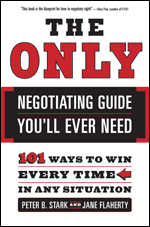Summary: Putting conditions on an agreement in order to protect oneself.
The Safeguard is employed when a relationship is new or you have little or no trust in it. The tactic is designed to protect you in the event that your counterpart does not live up to his negotiated deal point.
Example
A retailer or distributor offers to buy 50,000 units from a manufacturer for $1 per unit. The normal price for anything less than 50,000 units is $1.25 per unit. The manufacturer agrees to the $1 price but places a Safeguard into the contract that reads, “In the event that the distributor does not purchase 50,000 units by the end of the year, she will be back-billed 25 cents per unit.” Or the manufacturer stipulates that if the distributor has not ordered 50,000 units by the end of the year, the price effective in the new year will be $1.25 per unit. Both of these examples provide Safeguards to the manufacturer.
Counter
There are three effective counters the distributor could employ: (1) She could just Say “No” and Stick to Her Guns; (2) she could argue that her corporation has a policy that does not allow any type of back-billing; or (3) if she is interested in building a long-term relationship, she could negotiate a “tiered” price, agreeing to pay, for example, $1.35 per unit for orders up to 20,000, $1.15 per unit for additional units up to 40,000, and $1 per unit on any purchase over 40,000. Although shark-like negotiators might debate the wisdom of this last counter, being friendly and flexible helps build relationships. People are much more willing to help create a win-win outcome with a counterpart they like and trust.
Have you used or encountered this tactic in your negotiations? If so, how’d it go?




Speak Your Mind